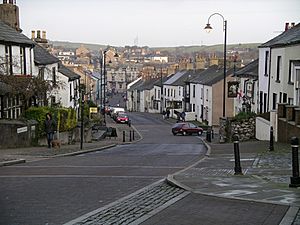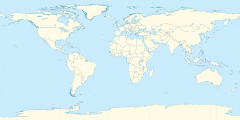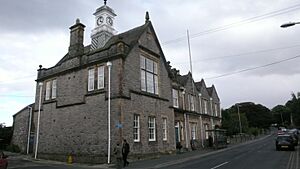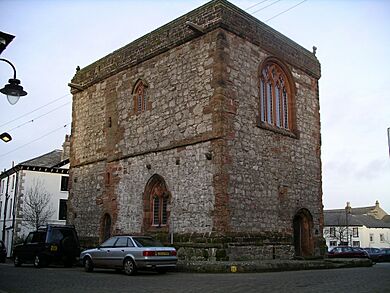Dalton-in-Furness facts for kids
Quick facts for kids Dalton-in-Furness |
|
|---|---|
| Town | |
 Market Street, Dalton-in-Furness |
|
| Area | 1.60 km2 (0.62 sq mi) |
| Population | 7,827 (2011 Census) |
| • Density | 4,892/km2 (12,670/sq mi) |
| OS grid reference | SD228738 |
| Civil parish | |
| Unitary authority |
|
| Ceremonial county |
|
| Region | |
| Country | England |
| Sovereign state | United Kingdom |
| Post town | Dalton-in-Furness |
| Postcode district | LA15 |
| Dialling code | 01229 |
| Ambulance | North West |
| EU Parliament | North West England |
| UK Parliament |
|
Dalton-in-Furness is a town in Westmorland and Furness, Cumbria, England. It is located about 4 kilometers (2.5 miles) northeast of Barrow-in-Furness. This town, along with the rest of the Furness peninsula, was historically part of Lancashire. Dalton-in-Furness is part of the parish of Dalton Town with Newton, which also includes the nearby small village of Newton-in-Furness. In 2011, the town had a population of 7,827 people.
Contents
History of Dalton-in-Furness
Dalton is mentioned in the Domesday Book of 1086. This was a very old survey of England ordered by William the Conqueror. In the book, Dalton was called "Daltune." It was one of the areas that belonged to the Manor of Hougun.
For a long time, Dalton was the main town, or "capital," of the Furness area. The old parish of Dalton used to cover a much larger area. This area later became the borough of Barrow-in-Furness.
Historically, Dalton was part of Lancashire. The town is connected to several famous artists, like George Romney. The Dalton Town Hall building was finished in 1884.
The Drill Hall in Dalton was opened in July 1929. It was a place for military training and a headquarters for soldiers before World War II. During the war (1939-1945), it was used by the Home Guard, a defense group. It had a rifle range until 2009. After the war, it became a headquarters for army cadets. Since the early 1990s, it has been a community and youth center for local young people.
Geography and Location
Dalton is located in the middle of Low Furness. It sits on the eastern side of a valley that runs across the peninsula. Just over a mile (about 1.6 km) to the south, you can find the old ruins of Furness Abbey. The closest major town, Barrow-in-Furness, is about four miles (6.4 km) to the southwest.
You can usually reach the area by using the A590 road. This road connects the M6 motorway to the Furness region. The A590 now goes around the town, which means less traffic directly through Dalton. This has allowed for traffic calming measures in the town.
The Dalton with Newton Town Council was the first group to join the Friends of Real Lancashire. This group works to recognize the traditional county borders of Lancashire.
Getting Around
The town has its own train station, Dalton railway station. It is on the Furness Line. This means you can travel by train to places like Barrow, Ulverston, Grange-over-Sands, and Lancaster. There are also longer train services to Preston and Manchester.
Local buses are run by Stagecoach Cumbria & North Lancashire. These buses offer routes to Barrow, Ulverston, Windermere, and Kendal.
Sports in Dalton
Dalton has several local sports teams.
Football
The local football teams are Dalton United and Crooklands Casuals. They play in the West Lancashire Football League.
Girls' and women's football is played by Dalton Girls and Ladies F.C. They have teams for younger players and adults. These teams play in different leagues across Cumbria.
There are also two junior football clubs. Crooklands Casuals has a larger setup with teams for ages under 8 to under 16. Dalton Junior F.C. offers football for younger players (under 8s, under 9s, and under 10s). Dalton JFC currently plays on the fields at Dowdales School.
Rugby League
Dalton Rugby League Football Club is located at the entrance to the town. They are currently in the first division of the North West Counties League. Their home ground was recently renamed Kelland Park. This was done to remember Ivor Kelland, a very important person in Dalton rugby league.
Cricket
Dalton Cricket Club plays in the North Lancs. & Cumbria Cricket League. Dalton won the first organized cricket match ever played in the Furness area, beating Barrow. The Cricket Club also has many junior teams, including Under 11s and Under 13s.
Education
Dowdales School is the main secondary school in Dalton. It has about 1,050 students. The school does not have a sixth form (for older students). Instead, students usually go to the Sixth Form College in Barrow. They can also go to Barrow and Kendal College for further education.
There are four primary schools in the town:
- Chapel Street School
- George Romney Junior School
- Dalton St Mary's Church of England Primary School
- Our Lady of The Rosary Catholic School
Media
For regional TV news, people in Dalton watch programs from Salford-based BBC North West and ITV Granada. Television signals are received from the Winter Hill and local relay transmitters.
Local radio stations include BBC Radio Cumbria on 96.1 FM and Heart North West on 96.9 FM. There is also Cando FM, which is a community radio station. It broadcasts to the town on 106.3 FM.
The local newspaper for the town is the North West Evening Mail.
Attractions to Visit
Dalton is only about a 15-minute drive from the edge of the Lake District National Park. However, it also has some interesting places to visit right in town:
- Dalton Castle (managed by the National Trust)
- South Lakes Safari Zoo
Twin Towns
Dalton is a twinned with Dalton, Pennsylvania, in the United States. This means the two towns have a special friendship connection.
Famous People from Dalton
Many interesting people have connections to Dalton:
- In 1614, Margaret Fell was born in Dalton. She was also known as Margaret Fox. She was very important in starting the Religious Society of Friends (Quakers). People often called her the "mother of Quakerism." She was one of the "Valiant Sixty" early Quaker preachers. She passed away in 1702.
- George Romney, a famous painter from the 1700s, was born and grew up in Dalton. Miles Romney, from the early 1800s, was also from Dalton. He is a direct ancestor of the U.S. politician Mitt Romney.
- William Ashburner (1737–1793), who was from Dalton-in-Furness, became the ancestor of a well-known family. This family included merchants and administrators in British-ruled India during company rule.
- Steve Dixon, a presenter for Sky News, was born in Newton-in-Furness. Richard T. Slone (born 1974), an award-winning artist, was also born there. Both were in the same school year and went to school in Newton and then Dalton-in-Furness. Turner Prize winner Keith Tyson (born 1969) also grew up and went to school here.
- E.B. Ford, a well-known scientist and author of a popular book about butterflies, was born in Dalton in April 1901.
- Tommy Johnson, a footballer, was born in Queen Street, Dalton-in-Furness, in 1901. He is the third-highest goal scorer for Manchester City. He played five games for England's national team and scored in every game.
See also
 In Spanish: Dalton-in-Furness para niños
In Spanish: Dalton-in-Furness para niños




